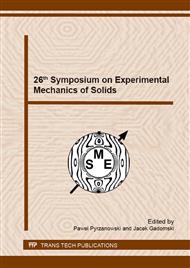p.81
p.87
p.94
p.101
p.108
p.114
p.122
p.128
p.137
Thermal Effect Accompanying Low Cycle Fatigue of Al-2024
Abstract:
When a material is subjected to a cyclic loading at high values of stress or strain, both thermal and damage develop together with cyclic plastic strain. These processes are often accompanied by damage deactivation characterized by actual state of micro-cracks, which are generally active under tension and passive under compression. In classical formulation damage deactivation occurs instantly when loading changes sign and consequently leads to non-smooth path separating both load ranges. The real materials, however, do not exhibit such bilinear paths. Therefore, the more realistic model based on continuous damage deactivation is proposed, in which micro-cracks close gradually, see Cegielski and Ganczarski [2, 3, 4], Hansen and Schreyer [5]. Simultaneously, thermo-mechanical coupling may play essential role in processes of cyclic plasticity hence present formulation comprises an additional heat transfer equation.
Info:
Periodical:
Pages:
108-113
Citation:
Online since:
August 2015
Authors:
Price:
Сopyright:
© 2016 Trans Tech Publications Ltd. All Rights Reserved
Share:
Citation:


